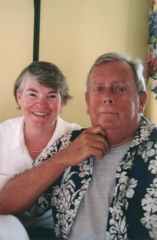Steptoe & Johnson enmassed a mammoth legal case, setting its sights on the Constitutional right to medical care. It was unproven and theoretical, but Steptoe’s associates reasoned that if a woman –based on her innate privacy and biological rights – can elect to abort a fetus than a man can elect to smoke marijuana to preserve his vision. And in Bob’s case it wasn’t even a matter of election. The decision of the lower court in U.S. v Randall had established medical necessity. Federally sponsored studies on Bob had confirmed his need for the drug. Surely the Constitution argument could prevail?
We’ll never know. At least with regards to Robert Randall. The U.S. District Attorney took a look at Steptoe’s brief, with its supporting documents and evidence, and immediately instructed the officials at NIDA, FDA, and DEA to give Randall the pot. One can only envision the whining that accompanied this order but in record time Dr. Richard North, a Washington, D.C. ophthalmologist to whom Bob was referred by Dr. Merritt, was approved to manage Bob’s care. Dr. North was required to file an annual report to FDA. But for all intents and purposes, Bob was receiving marijuana just as he did his other medications. Dr. North wrote a prescription which Bob took to a pre-arranged pharmacy where he received his marijuana. The feds could call it research but it was, in fact, medical access.
Additionally, the Steptoe brief specifically addressed Robert’s right to free speech arguing that his access to marijuana was terminated, in part, because of his outspoken advocacy for the therapeutic use of marijuana. The Steptoe case referenced a letter that Bob received from [Peter Bourne] President Carter’s Drug Advisor in June 1977 which contained a clear threat: “Publicity in [your] case has forced consideration of tightening up the dispensing of your supplies.”
So, resolution of the case in March 1978 really addressed the two fundamental concerns that we had: 1) it established a reasonable means of legally obtaining federal supplies of marijuana under a doctor’s supervision, and 2) it virtually guaranteed Robert the right to speak freely about marijuana’s therapeutic utility.
In coming years there would be other interruptions of his supplies. This was particularly true as Administrations changed and new officials thought they could silence Robert by disrupting his supplies. But Steptoe was always there for him and a few well placed phone calls, with references to the 1978 settlement, would quickly resolve the problem.
But Steptoe did much more for us. Indeed, it was this alliance – Bob and Steptoe & Johnson – which would cement the future of the medical marijuana issue for the next fifteen years. With Steptoe’s help Bob and I founded the Alliance for Cannabis Therapeutics in 1980. ACT lobbied hard for federal legislation (drafted by Steptoe) which would have established a federal program of legal access to marijuana for those with life- or sense-threatening diseases. The bill [HR 4498] was introduced in 1981 by four Republicans. Among them was a young Georgia Representative named Newt Gingrich
The bill would eventually draw 110 co-sponsors. Hearings, however, were never held because Committee Chairman Henry Waxman perceived the bill as a Republican effort and he also worried that it would detract from his own interests in re-establishing heroin as a legitimate therapeutic agent.
Later still, in the mid-1980s, Steptoe attorneys took over the long-languishing NORML effort to re-schedule marijuana. It was their commitment to the issue which allowed the hearing before DEA Administrative Law Judge Frances Young to become the single most comprehensive hearing on marijuana’s therapeutic application since the India Hemp Commission of 1893
So, that is some of the story behind Robert Randall’s historic access to marijuana for treatment of glaucoma. In some ways Bob’s story reminds me of “The Perfect Storm” – which is defined as “any only-remotely-possible … confluence of singly innocuous events. In such a situation, it is clear that if any one element had been displaced in time or space the result would have been far less powerful, but because just the right things were in the mix and with just the right timing, the situation ballooned.” Perfect storms are normally viewed as disastrous and, for the drug warriors in the federal government I think Bob Randall was a disaster. He was a single individual who changed the course of America’s drug war and gave Americans the truth about marijuana.
If he were here today I know he would thank Mary Lynn Mathre and Al Byrne for continuing the efforts that ACT started and taking them a step further by truly organizing the scientists and members of the medical profession who are so key in resolving this issue. And he would congratulate all of you who are working so hard to legitimize this therapy by developing new delivery methods. But he would also remind you that many people have no time to wait. What, he would ask, are we doing for those people?
Robert Randall was, indeed, the Father of the Medical Marijuana Movement. In 1976 you would have been hard pressed to find anyone who knew of marijuana’s medical value. Today nearly everyone is aware and 80% of the American public support prescriptive access to the drug. To a large extent it was Robert Randall who educated America about marijuana’s medical utility. He took the moral values that were instilled into him by loving parents and the education that they gave him, and engaged America in a dramatic discourse on the therapeutic utility of marijuana. And while he would have loved to see the day when marijuana was legally available by prescription he was also realistic enough to say, “Legal or illegal, marijuana works.”
In short, he helped a lot of good people through some really hard times.
So, I think we all owe Robert a thank you. Thank You Robert.

Bob Randall and Alice O’Leary in May, 2000